Shining a Light on UV Materials
In an attempt to bring some clarity to the muddy waters of fly-tying materials, and although I have no formal scientific training in this topic, I have spent a lot of time researching ultraviolet (UV) materials and the hubbub surrounding them. I have had some trial and error with my treasure trove of materials on the flats, and between that experimentation and my research, I’ll try to explain what fish might be seeing.
UV reflective materials do not react under a UV light. This means that particles of light in the UV spectrum that hit the material will be reflected and become more visible to predators that can see UV light. If no light is present, then there is no UV light either. If there is no UV light, then there is no UV reflection from the materials.
If birds, fish, and insects can see UV light, and humans cannot, materials that claim to be UV reflective cannot be tested with a blue light or a UV light since they simply reflect UV light, which we cannot see.
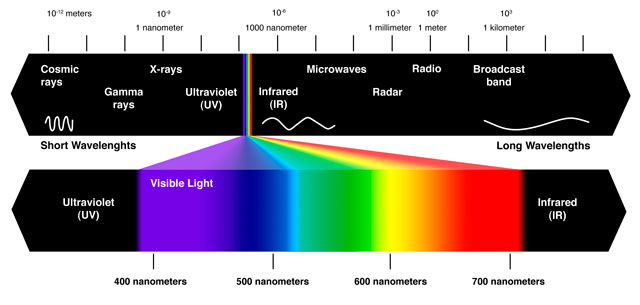
The visible spectrum shown in the colored portion of this diagram illustrates what is visible or can be detected by the human eye.Shorter wavelengths of light such as ultraviolet or (UV) light are not visible to humans and can only be seen by birds, insects, and fish.
Most but not all feathers are UV reflective. Some feathers reflect more UV light than others, such as jungle cock, peacock, and iridescent exotic bird feathers. However, birds in the ostrich family, owls, and hummingbirds have no UV reflective feathers at all. Bright-colored plumage and UV reflection may play a role in how these birds interact or communicate, especially when it comes to choosing a mate. UV reflective materials call attention to your fly against a dark non-UV reflective background and may trigger a strike. UV reflectivity matters most in low-light situations and at long distances in any direction, not just down. The farther away the materials can be seen, the better your chances are of attracting fish.
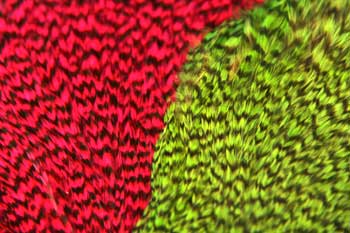
Colors like chartreuse and hot pink are automatically UV reactive and can be seen at a great distance underwater. They have proven to be productive colors for a number of species and have become standard choices for most saltwater attractor patterns.
White or lighter colored feathers are highly UV reflective, while darker or black feathers reflect far less UV light. White has the highest UV reflectivity, followed by blue, yellow, green, red, brown, and then black. Highly reflective UV colors like fluorescents are not typically found in nature, but they work well to get the attention of fish.
So what are you seeing when materials light up in the dark when you shine a UV light on them? These are UV reactive materials. UV reactive materials shine, radiate, incandesce, or fluoresce when you hit them with a UV light. Typically this means they have been dyed with UV reactive dyes. Highly UV reactive materials can be checked with a UV light. They gather light and fluoresce or luminesce in the dark. Materials that appear fluorescent in daylight absorb UV and reflect, or radiate, with a brighter intensity.
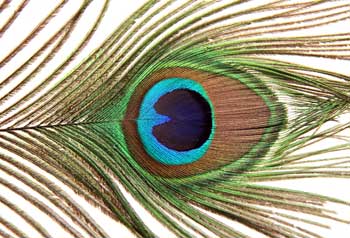
Peacock feathers are known for their iridescent qualities and are used as a fly-tying material in both freshwater and saltwater patterns. They are brightly colored feathers and are an excellent example of a UV reflective material.
One theory why highly UV reactive colors like chartreuse are so effective is that in some way they mimic blood in the water. However, blood does not react to UV light in the same way as UV reactive colors do. Many popular crime shows on TV portray blood as glowing when exposed to a UV light, but this is simply not true. In order for blood to glow, it needs to be treated with a reactive chemical, which makes the blood glow in the dark briefly even without a UV or black light. When exposed to UV light, blood absorbs the light but does not fluoresce; instead it appears black.
If a hemorrhaging baitfish appears black underwater, its image is a silhouette against a light background. Since most mortally injured fish float to the top eventually, its dark shape contrasts sharply against the brighter, sunlit backdrop. A silhouette is easily seen underwater at great distances, especially in stained or dark water. Again, the more visible a fly is, the better.
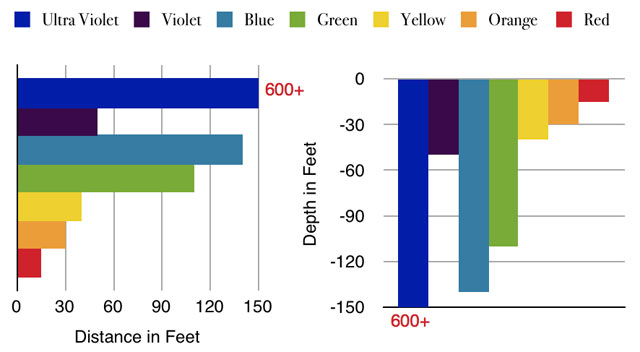
If you have spent any time scuba diving, you have probably noticed that some colors become less vibrant and eventually appear gray the deeper you go. This is because visible light can only penetrate so far in any direction, depending on the clarity of the water. This chart shows the estimated distance that visible and ultraviolet light can penetrate.
Each color fades and eventually appears gray at a different depth. UV light penetrates deeper in the water column than visible light does, so UV reflective or reactive materials are visible at greater distances. The colors of the visible light spectrum are gradually absorbed, depending on the color and clarity of the water. Colors with the highest energy, like red, orange, and yellow, disappear or dissolve to gray first and cannot be seen as you get deeper or farther away. This is important when selecting a fly or choosing the colors of materials for tying your next pattern. Not only do you need to take into consideration the color of prey you are trying to emulate, but you also need to consider the clarity of the water, the light conditions, and the depth that you will be fishing in. All these factors may affect how the fish sees the fly and ultimately how productive the fly is at attracting fish.
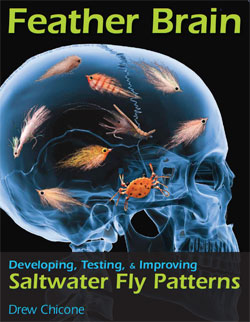
Buy Feather Brain
Visibility is much better in clear water than it is in cloudy, dark, or stained water. Clear water allows light, both visible and UV, to penetrate much more efficiently. The brighter the light, the better and farther away colors can be seen. Absence of light due to dark or stained water, time of day, or depth, reduces the depth and distance that a color can be seen. That is why on cloudy days, flies that have high contrast or a strong silhouette typically produce better than a specific color of fly . . . which explains the old rule “Bright colors on bright days, dark colors on dark days.” It is a matter of getting something in front of the fish that can clearly be seen.











